On Architosh’s Day 1 recap article I discussed GRAPHISOFT’s 2017 BIMCON event in general and highlighted several of the first-day learning sessions. Day 2 continued much as Day 1 did with 6:30 am breakfast buffet morning call and single 7:00 am learning session for those early risers.
On Day 2 the 7:00 am single session was titled “Advanced CineRender.” If it wasn’t for my love of breakfast, I would have attended this session that focused on instructing ARCHICAD users in the use of the rendering engine inside ARCHICAD 20 which comes from sister company Maxon Computer.
Because this technology is relatively new to ARCHICAD, the likelihood that users know it well is small; hence, the value in an in-depth session covering how to setup your scene, add lighting, edit materials, and use CineRender’s surface channels, among other things.
Session Highlights Day 2—GDL for Everyone and VR
Just to give readers a sense of the scope of options, each session time block tended to have six learning session options to choose from. The good news was several did repeat at other times, so participants didn’t always have to miss something when two compelling sessions competed in the same period.
Surprisingly Popular—the GLD Sessions
One of those repeating sessions that I could not attend on Day 1 was titled “Making GDL Easy—for Everyone,” by Patrick May, BIM Coordinator and owner of 4d Proof. A graduate of the University of Oregon Architecture program in 2008, May was one of the younger architects I had a chance to talk to at BIMCON and proof that ARCHICAD’s use by leading design-oriented practices often serves as a point of first entry to this particular BIM solution.
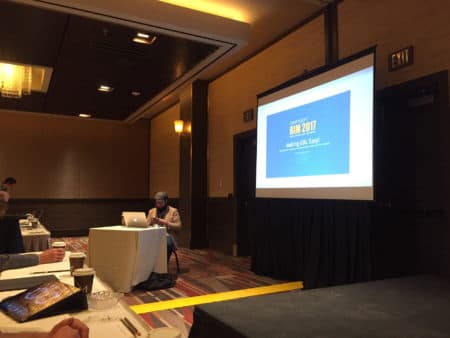
01 – Patrick May waits patiently as attendees take their seat for his popular GDL Made Easy learning session.
In the case of Patrick May, prior to starting 4d Proof, he passed through the noted San Francisco firm, Walker Warner Architects, helping this well-published practice focused on contemporary high-end residential architecture with the management of their BIM systems. I noted earlier that May’s GDL session—which he initially thought was not going to be accepted for the event—turned out to be extremely popular.
MORE: 2017 BIMCON: Five Disruptive Thoughts Shared at GRAPHISOFT’S User Conference
Patrick told me in a discussion that he mastered ARCHICAD in about three years working for his first firm directly out of architecture school. In general, I have been struck by the number of ARCHICAD experts blooming in the industry who are quite young in years. Anyway, I have an interview on May coming up which delves more into his development using this BIM program and what attracted him to ARCHICAD and GDL.
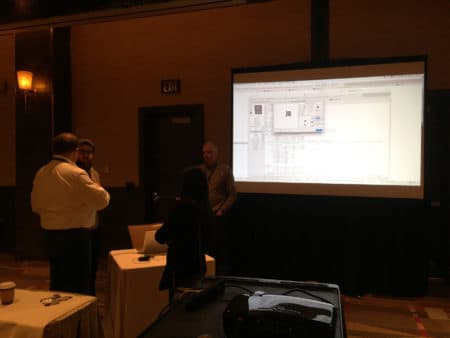
02 – After the learn session, May had many participants interested in following up with private questions. On the screen there. ARCHICAD’s GDL scripting environment.
Back to the session itself, GLD is similar to BASIC and is the parametric programming language in ARCHICAD. May showed the attendees a process of working with this language simply for the purpose of making custom objects. The goal of the session was making your own custom objects with parametric aspects. He started the session taking an object from the SketchUp 3D Warehouse, a popular source for 3d models. Then he showed the audience how to get it into ARCHICAD and clean it up for best use. Participants learned how to save both 2D and 3D appearances for these custom objects and management into a library for easy access on multiple projects.
VR/AR/MR with ARCHICAD
Another highly attended larger session was by Willard Williams. Williams’ session was a somewhat intense (at least for some) walk through of the key technologies necessary to take ARCHICAD models into VR/AR/MR environments through gaming engine technologies.
Williams is another member of what one might call the new, young ARCHICAD super users. For starters, he has a diverse professional background and currently works for one of the largest construction companies in the United States. He also told me over lunch that he also worked at Walker Warner in San Francisco. (same as Patrick May).
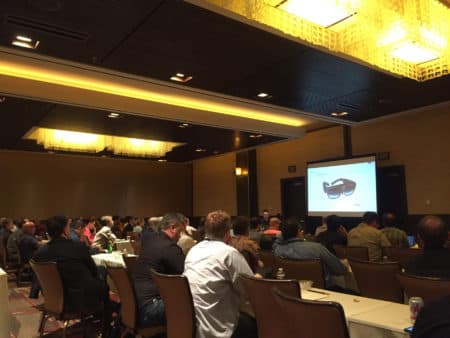
03 – I sat in the back of William Willard’s learning session so my apologies as these are not the best photos. Willard is discussing the overall pipeline for taking ARCHICAD models to game engine environments to get them into VR/AR/MR device experiences.
Back to the session, the key takeaway was the use of the Unity game development platform as the hub for where you go next after you get your ARCHICAD model into it. Williams noted that whether you are interested in AR/MR with Hololens or VR with Vive or Oculus, you need to target a gaming engine from whence to go next. The path to the gaming engine looks like this: ARCHICAD to Cinema 4D (also a Nemetschek SE company) and out to FBX (a file format that is highly used within the M&E markets that Autodesk owns.).
Williams also noted the value of Rhino for optimizing the FBX files. For users working with the Rhino-Grasshopper-ARCHICAD Connector, they are already setup to plug Rhino into this process of optimization.
This session was more of an advanced user session on multiple fronts. The discussions about the gaming engine technology, use of external GPUs with a mobile device like the Razer Blade, and the like, put the tech talk quite up there for the average BIM user. Unfortunately, this particular subject is nascent in the industry, and early adopters must cope with tech details like this. My personal view was this was highly valuable for those users who have the more advanced tech skills to put it all together.
Closing Thoughts on Sessions
Overall, there was an appealing mix of learning sessions at this small user conference. For practicing architects, they had a chance to gain AIA CEUs while learning subjects that went beyond the digital tools at hand. That’s where the “rubber hits the road” as they say.
For example, even a session by GRAPHISOFT itself focused on ADA compliance techniques earlier in design work. I’ve already noted the learning session on envelope design and Orcutt Winslow’s team session on sustainability practice.
Kushner Closing Keynote
At the end of Day 2, prior to an evening of networking and food, GRAPHISOFT had one more amazing keynote lined up for the hundreds of architects and design professionals in attendance. Marc Kushner, architect, and CEO and co-founder of Architizer.com was the closing keynote speaker.
Kushner’s talk—which I understand was close to his popular TED Talk—had one over-arching message that architects needed to hear: “there’s a revolution going through architecture…a media revolution. And it’s sitting in your pocket.” Those were intriguing words from Kushner and they set the tone nicely.
Kushner’s talk encouraged architects to understand this media revolution and how it is transforming how the public—and by extension clients—are coming to both evaluate, judge, comment, reject or accept the world of architecture that professional architects plan for them. He noted the importance of high-end photorealistic visuals and the new social media landscape and how for the first time the public can come to bear witness to new works of architecture and socially engage with them before they are even constructed.
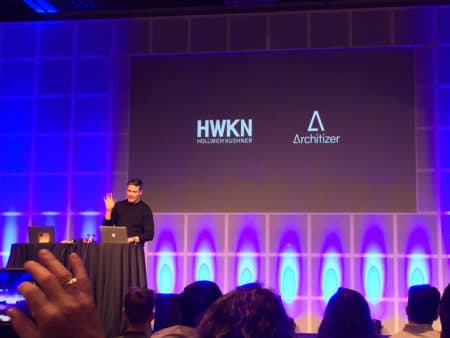
04 – Kushner is both a practicing architect and CEO of Architizer.com. His closing keynote was extremely well received by the audience at BIMCON.
Noting the evolution of the architectural style Brutalism and its determined rejection by the public as a whole, Kushner casts the profession’s response to public concern in a negative light. On the one hand, architects either retreated into esoteric and philosophically driven modernism like deconstructionism or went the other way and devolved into popularism in the form of commonly understood architectural memes and tropes.
Putting up a slide of the Greek Parthenon and then one of a horrendous classically inspired library in his hometown in New Jersey, he decried: “Symbols are cheap; instead of building places we build memories of places.” But the contextualizing and symbolic placemaking of the 1980’s had a sudden usurper in its midst. In the wake of the post-modernism gone awry in the ’80’s, Frank Gehry bust onto the architectural world with the Bilbao Museum in Spain.
“Bilbao fundamentally changed how the public perceived architecture,” Kushner noted. Rhetorically he asked, “how did that happen?”
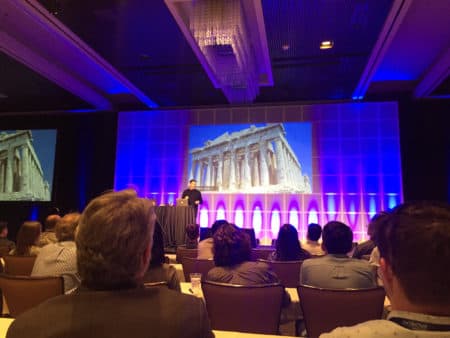
05 – Kushner spoke about the power of symbols in architecture as proxies for places long since gone. “Instead of building places we build memories of places.” he decried.
It happened by way of three core changes. Firstly, big media fell in love with it and claimed it great. This attraction, in turn, drove sales at the museum, buttressing the argument that critically risky architecture can be profitable. Thirdly, the news of this virtuous cycle of acclaim and financial success spread quickly.
Ultimately where Kushner was taking the audience was to the point that today’s feedback loops in global society have collapsed in time. And dramatically. In noting the work Gehry was doing for Mark Zuckerberg (for Facebook’s headquarters), and how it got posted to Facebook first, the news world got turned on its head when it was the New York Times asking for permission to repost a picture of the news and not the other way around.

06 – Gehry’s Bilbao Museum represents a tipping point in the world of architecture. It gave birth to the star architect but also to how the media and public relate to new cutting edge architecture.
Kushner ultimately brings up the reason for why he created a user-generated content platform like Architizer. It was simple. He didn’t have any leverage or influence over the gate-controlled architecture media. “And I didn’t know anyone at the New York Times,” he stated. Unable to get the word out about his young firm’s work, the idea for Architizer was hatched. The purpose was simple. Give architects the world over a platform to show off their talents and accomplishments.
Now Architizer is a huge worldwide site where architects learn about other architects but more importantly learn about the materials and teams that help create the buildings they are looking at. More than just a place to post your firm’s work into a beautiful gallery, Architizer is also an “implicit recommendation or endorsement marketing” engine. People—the public and the professionals—can “like” your work just like they like your Facebook photos.
Kushner’s point is that “transparency and getting your voices heard can change how architects are valued.” And this is important because the industry is constantly painted with concern that they are not.
Closing Thoughts on 2017 BIMCON
It is always nice to see the results of professionals just like you, fighting the good fight, using the same tools, battling the same battles. And so, it goes without saying that user conferences the world over, across an array of industries, tend to showcase the most accomplished among their corps.
Certainly, in the case of Kai-Uwe Bergmann, a partner at BIG, his keynote fit that bill perfectly. BIG not only uses ARCHICAD as its main BIM platform in their Copenhagen headquarters, the firm is arguably the biggest star architecture practice in the world today. The way he demonstrated and spoke about the firm’s projects was both entertaining and instructive.
So the big surprise in the BIMCON event, at least for this architect and writer’s eyes, is that Kushner’s closing talk demonstrated the alternative path—bring in a “thought leader” who is, at a bare minimum, tangential to the industry and the concerns of those in attendance. But Kushner—while fitting the bill as a thought leader—goes beyond the minimum; he lives and breathes the same problems all architects do. And this was the delight in his keynote. He brought both thought-leadership coming from a view outside the field but at the same time being among the field.
GRAPHISOFT will have a hard time equaling a pair of keynote speakers for future events like this one. I attend many industry events, including AIA Nationals, and it is easy to judge this event’s headline speakers as topping even the AIA’s national conferences, which recently have devolved into the use of Hollywood celebrities or former US presidents.



Reader Comments
[…] is also the co-founder of Architecture super site Architizer.com. And he is here at GRAPHISOFT’s user conference to share some news—some fantastic information—that architects may not be acutely aware […]
[…] is also the co-founder of Architecture super site Architizer.com. And he is here at GRAPHISOFT’s user conference to share some news—some fantastic information—that architects may not be acutely aware […]
Comments are closed.